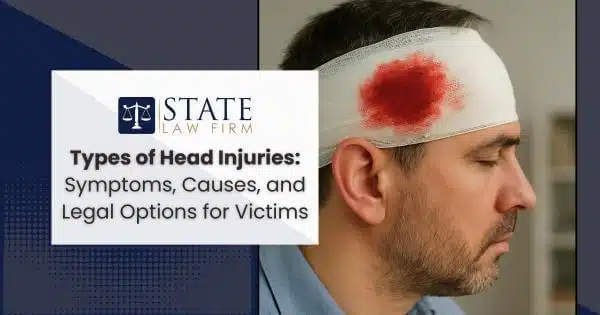Head injuries are far more common—and much more severe—than many people realize. Each year, an estimated 1.5 million Americans sustain a traumatic brain injury, leading to hospitalizations, long-term disabilities, and, in severe cases, loss of life (CDC). Whether caused by a sudden fall, a violent impact in a car accident, or a sports-related collision, head injuries can disrupt nearly every aspect of daily living.
At State Law Firm, we understand how overwhelming it can feel when you or someone you love experiences a head injury. As a boutique personal injury law firm in Sherman Oaks, our dedicated team of young attorneys is committed to guiding clients through complex legal challenges while fighting for the resources and accountability they deserve.
This article is designed to be a clear, accessible resource to help you understand:
- The different types of head injuries, from concussions and contusions to skull fractures and penetrating trauma
- The symptoms and warning signs you should never ignore
- Common causes of head injuries include vehicle collisions and falls.
- The critical importance of seeking prompt medical care
- Your legal options if negligence played a role in your injury
If you’re exploring your next steps, whether for yourself or a loved one, you don’t have to navigate this alone. Our team is here to help you pursue justice and protect your future. To learn more about the long-term impact of traumatic brain injuries, you can also read our guide on the lasting effects of TBIs. And if your injury was caused by a vehicle accident, our Sherman Oaks car accident lawyers are ready to advocate for you every step of the way.
Understanding Head Injuries: An Overview of Different Types
Head injuries can range from relatively mild to life-threatening, and understanding the different types is the first step toward protecting your health and your rights.
- Traumatic Brain Injury (TBI): A disruption in normal brain function caused by a blow or jolt to the head. TBIs are classified as mild, moderate, or severe.
- Concussions: Often referred to as mild TBIs, concussions can still have serious consequences if untreated or repeated over time.
- Contusions: Bruising of the brain tissue, typically caused by direct impact. Severe contusions can lead to dangerous swelling.
- Skull Fractures: Breaks or cracks in the skull bone. These injuries can accompany brain damage or bleeding.
- Penetrating Head Injuries: Occur when an object pierces the skull and enters brain tissue, often requiring emergency surgery.
Pro Tip: Even a seemingly minor head injury should be evaluated by a doctor—symptoms can worsen unexpectedly, and early intervention can prevent long-term damage.
Common Symptoms Associated with Various Head Injuries
Recognizing symptoms early can make all the difference in recovery and treatment outcomes. Symptoms vary based on the severity and type of injury, but often include:
- Persistent headache or pressure in the head
- Loss of consciousness, even briefly
- Dizziness or balance issues
- Nausea or vomiting
- Blurred vision or light sensitivity
- Confusion, memory loss, or trouble concentrating
- Slurred speech
If you experience any of these symptoms after an accident or impact, seek immediate medical attention. Untreated injuries can lead to significant complications, including cognitive impairment and personality changes.
The Causes Behind Head Injuries: Recognizing Risk Factors
Understanding how head injuries happen helps reduce risks and identify negligence when accidents occur.
Some of the most common causes include:
- Falls: Especially common among children and older adults, falls can lead to concussions or skull fractures.
- Vehicle Collisions: Car, motorcycle, and bicycle accidents are leading causes of TBIs. If you’ve been involved in a crash, visit our Sherman Oaks car accident lawyer page to learn about your legal options.
- Sports Injuries: Contact sports and recreational activities can result in concussions and more severe trauma.
- Violence: Assaults, domestic violence, and gunshot wounds are also sources of penetrating or blunt force injuries.
Pro Tip: Documenting the cause of your injury—through photos, witness statements, or incident reports—can strengthen a future compensation claim.
The Importance of Medical Evaluation and Treatment for Head Injuries
Prompt medical care is crucial to prevent further harm and establish a clear record of your injury. Depending on the severity, treatment may involve:
- Emergency care: Stabilizing breathing, circulation, and intracranial pressure
- Imaging tests: CT scans and MRIs to assess damage
- Concussion management: Rest, cognitive rehabilitation, and gradual return to activity
- Surgical intervention: Removing clots or repairing fractures in severe cases
Long-term effects of untreated TBIs can be profound, from memory deficits to personality shifts. If you’d like to explore this further, read our detailed article on the long-term effects of traumatic brain injuries.
Navigating the Legal Landscape: Options Available for Victims of Head Injuries
When someone else’s negligence caused your injury—whether a reckless driver, an employer who failed to maintain a safe environment, or a property owner who ignored hazards—you may have the right to pursue compensation.
Potential legal avenues include:
- Personal Injury Claims: Seek damages for medical bills, lost wages, pain and suffering, and more.
- Workers’ Compensation: If your injury happened on the job, you may qualify for benefits regardless of fault.
- Third-Party Liability Claims: When another party contributed to a work-related injury, a separate claim may be possible.
- Product Liability: If defective equipment or safety gear contributed to your injury, you may have a claim against the manufacturer.
Hiring an experienced attorney who understands both the medical and legal complexities of head injuries can make the process less stressful and more successful. At State Law Firm, our team is committed to helping you feel informed, empowered, and fully supported as you explore your options.
Pro Tip: Acting quickly is essential. California law sets strict deadlines for filing personal injury claims, so don’t wait to get answers about your case.


